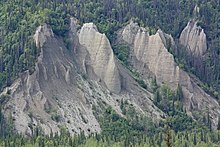
Back عملية نهرية Arabic फ्लूवियल प्रॉसेस Bihari فرایندهای رودخانهای Persian नदीय प्रक्रिया Hindi 河川作用 Japanese 하천작용 Korean Argerdhow avon KW Fluviatiel proces Dutch Fluviale prosessar NN Fluviale prosesser NB

In geography and geology, fluvial sediment processes or fluvial sediment transport are associated with rivers and streams and the deposits and landforms created by sediments. It can result in the formation of ripples and dunes, in fractal-shaped patterns of erosion, in complex patterns of natural river systems, and in the development of floodplains and the occurrence of flash floods. Sediment moved by water can be larger than sediment moved by air because water has both a higher density and viscosity. In typical rivers the largest carried sediment is of sand and gravel size, but larger floods can carry cobbles and even boulders. When the stream or rivers are associated with glaciers, ice sheets, or ice caps, the term glaciofluvial or fluvioglacial is used, as in periglacial flows and glacial lake outburst floods.[1][2] Fluvial sediment processes include the motion of sediment and erosion or deposition on the river bed.[3][4]
- ^ Neuendorf, Klaus K.E.; Mehl, James P. Jr; Jackson, Julia A., eds. (2011). Glossary of Geology (5th revised ed.). Alexandria, Virginia: American Geological Institute. p. 800. ISBN 978-3-642-06621-4. OCLC 751527782.
- ^ Wilson, W.E. & Moore, J.E. 2003. Glossary of Hydrology, American Geological Institute, Springer, 248pp.
- ^ Charlton, Ro (2008). Fundamentals of fluvial geomorphology. London: Rutledge. p. 234. ISBN 978-0-415-33454-9.
- ^ Wohl, Ellen (2014). Rivers in the Landscape: Science and Management. Wiley-Blackwell. p. 330. ISBN 978-1-118-41489-7.